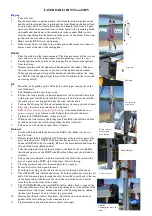
5. Open the factory-installed manual pull station that is as-
sembled to the exterior of the PrePaK’s 24VDC Terminal
Box. This will energize the solenoid valve open. Doing
so will result in a sudden drop of water pressure in the
deluge valve’s push rod chamber.
6. Reset the system per the directions listed in “System
Setup” section of this bulletin.
Draining Excess/Condensate Water From System
Refer to Figs. 10, 11 or 12 (depending on system size)
1. Close the main valve controlling water supply to deluge
valve. Also close valve A and open main drain valve B.
2. Open condensate drain valve H until all water has
drained. Close valve H.
Note:
Be sure not to keep valve
H open for an extended period of time because that will
cause enough system air to bleed off thereby actuating
the Model LP Dry Valve Actuator (see Table A for pneu-
matic pressure values required to maintain the Model
LP Dry Valve Actuator closed for a given water supply
pressure). If the Actuator does happen to actuate, the
entire system must be re-established in the correct or-
der as to avoid any possibilities of false-tripping of the
deluge valve. Proceed according to the directions listed
in the “System Setup” section of this bulletin.
3. Close main drain valve B. If system contains pressur-
ized air, allow air pressure to come back up to specifica-
tion. Open valve A first, and then open the main valve
controlling the water supply to the deluge valve.
9.
SOLENOID VALVE INSPECTIONS, TESTS
AND MAINTENANCE
WARNING: THE OWNER IS RESPONSIBLE FOR MAIN-
TAINING THE FIRE PROTECTION SYSTEM IN PROP-
ER OPERATING CONDITION. ANY SYSTEM MAINTE-
NANCE OR TESTING THAT INVOLVES PLACING A
CONTROL VALVE OR DETECTION SYSTEM OUT OF
SERVICE MAY ELIMINATE THE FIRE PROTECTION
OF THAT SYSTEM. PRIOR TO PROCEEDING, NOTIFY
ALL AUTHORITIES HAVING JURISDICTION. CONSID-
ERATION SHOULD BE GIVEN TO EMPLOYMENT OF
A FIRE PATROL IN THE AFFECTED AREA.
WARNING: PRIOR TO OPERATING THE SOLENOID
VALVE, BE SURE TO CLOSE THE SYSTEM CONTROL
VALVE TO AVOID UNINTENTIONAL OPERATION OF
THE DELUGE VALVE
1. Inspections: It is imperative that the system be in-
spected and tested in accordance with NFPA 25 on
a regular basis. The frequency of the inspections
may vary due to contaminated water supplies, cor-
rosive water supplies, or corrosive atmospheres. In
addition, the alarm devices, detection systems, or
other connected trim may require a more frequent
schedule. Refer to the system description and ap-
plicable codes for minimum requirements.
2. The valve must be inspected at least monthly for
cracks, corrosion, leakage, etc., cleaned and re-
placed as necessary.
3. If leakage is suspected through the solenoid valve, it
should be replaced.
Summary of Contents for DDX PrePaK
Page 3: ...3 Fig 1 ...
Page 11: ...11 Fig 3 ...
Page 12: ...12 Fig 4 ...
Page 13: ...13 Fig 5 ...
Page 14: ...14 Fig 6 ...
Page 15: ...15 Fig 7 ...
Page 16: ...16 Fig 8 ...
Page 17: ...17 Fig 9 ...
Page 18: ...18 Fig 10 ...
Page 19: ...19 ...
Page 20: ...20 Fig 11 ...
Page 21: ...21 ...
Page 22: ...22 Fig 12 ...
Page 23: ...23 ...
Page 25: ...25 Fig 13 ...
Page 27: ...27 Fig 14 ...
Page 28: ...28 Fig 15 ...
Page 29: ...29 Fig 16 ...










































